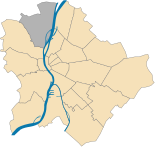III. Budapest district
|
Óbuda old furnace III. Budapest district |
|||
|
|||
| Basic data | |||
|---|---|---|---|
| State : | Hungary | ||
| Region : | Central Hungary | ||
| County : | Budapest | ||
| Coordinates : | 47 ° 32 ' N , 19 ° 3' E | ||
| Area : | 39.69 km² | ||
| Residents : | 123,552 (Jan. 1, 2011) | ||
| Population density : | 3,113 inhabitants per km² | ||
| Postal code : | 1031-1039 | ||
| KSH kódja: | 18069 | ||
| Structure and administration (as of 2020) | |||
| Community type : | district | ||
| Structure : | Districts
|
||
| Mayor : | László Kiss (DK) | ||
| Postal address : | Fő tér 3 1033 Budapest |
||
| Website : | |||
| (Source: A Magyar Köztársaság helységnévkönyve 2011. január 1st at Központi statisztikai hivatal ) | |||
The III. District of the Hungarian capital Budapest is also called Óbuda ( German Alt-Ofen or Alt-Buda ). Up to December 1849 Óbuda was an independent city, but was then incorporated into the city of Buda for administrative and tax purposes . Later, on January 1, 1873, when Buda (German oven) was united with Pest in Budapest, Óbuda also became part of the newly founded capital. As part of the administrative reform of 1950, the municipality of Békásmegyer (German Krottendorf) was attached to the third district.
history
Settlement areas from the Stone Age can already be found in Óbuda. The Romans founded the city of Aquincum here , the capital of the province of Pannonia , which was already famous for its baths and healing springs. The Magyars , i.e. the Hungarians, occupied the Pannonian Basin when they conquered the Pannonian Basin around 900 and built an important settlement here, which the later King Béla IV made the capital of the kingdom after the Mongol attacks in 1241 and 1242 .
Attractions

The sculpture was unveiled on March 28, 2013 in Bécsi út .
The center of the former town is the Fő Tér, the Óbuda Town Hall Market, which is still almost completely surrounded by old buildings. The castle of Count Zichy , who owned Óbuda for a long time after the Ottomans were driven out, and the synagogue of Óbuda are also located here .
Web links
Individual evidence
- ^ Janos Hauszmann: Brief History of Budapest . Regensburg 2012, p. 104.



